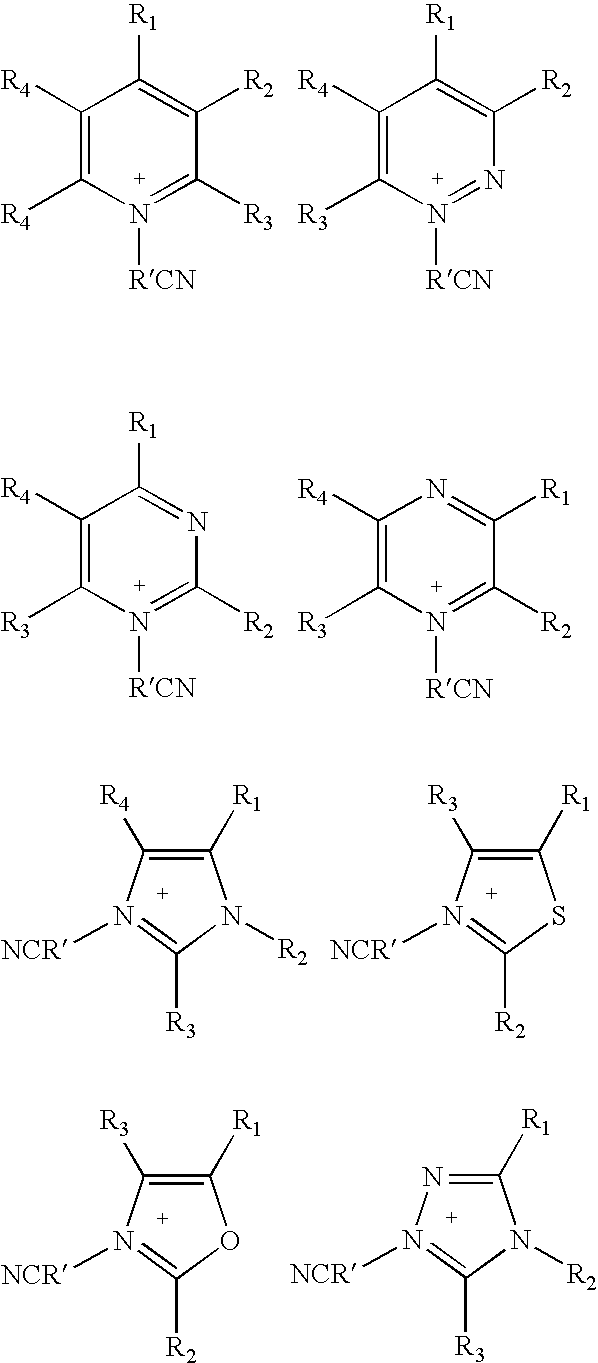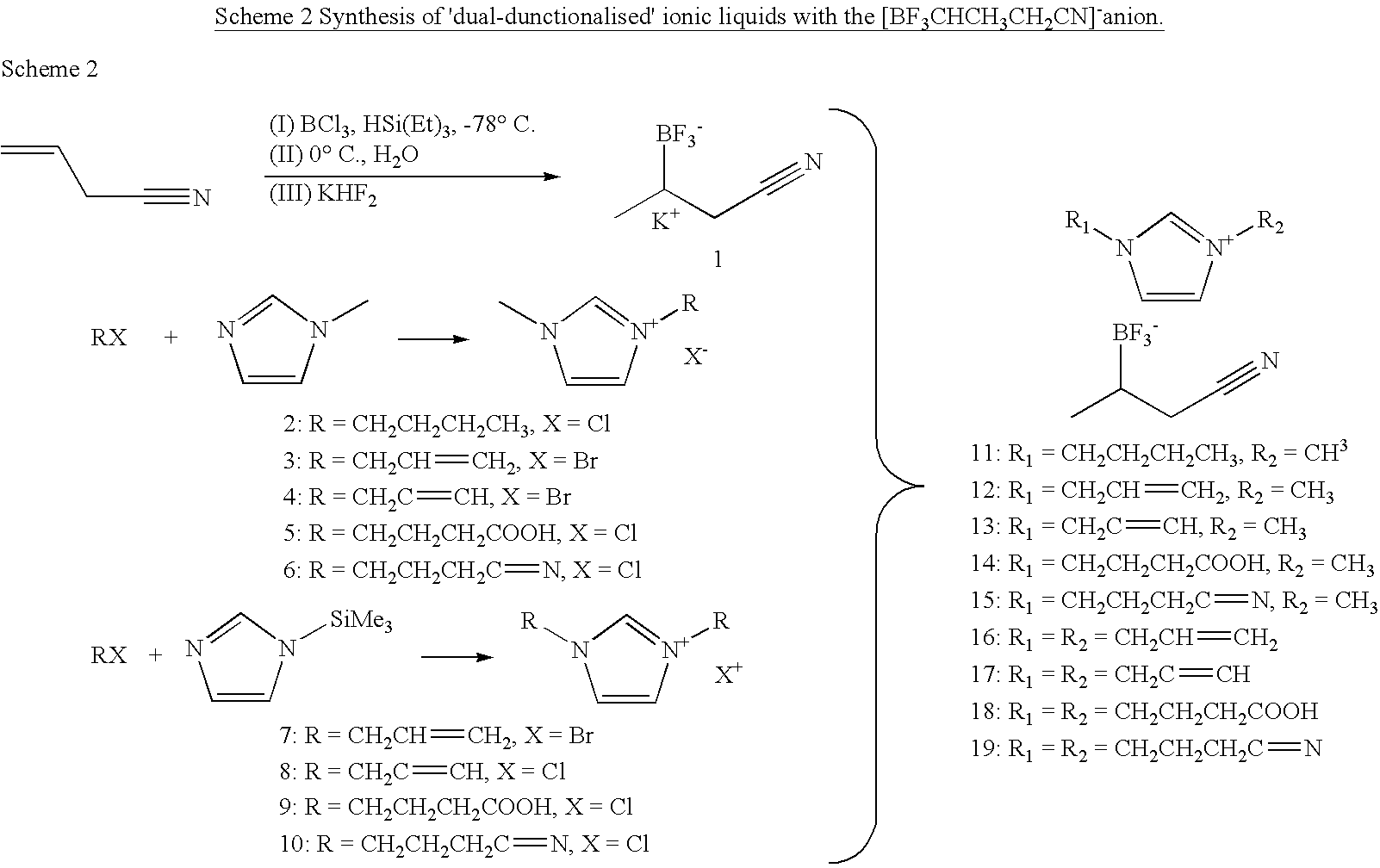Ionic Liquids Based on Imidazolium Salts Incorporating a Nitrile Functionality
a technology of imidazolium salts and ionic liquids, applied in the direction of organic compounds/hydrides/coordination complex catalysts, physical/chemical process catalysts, dissolving, etc., can solve the problem that the anionic component can decompose on contact with atmospheric moisture, the ability to coordinate to lanthanide and actinide series and transition metals to give catalytically useful complexes is limited, and the temperature required to complete the reaction is also increased.
- Summary
- Abstract
- Description
- Claims
- Application Information
AI Technical Summary
Benefits of technology
Problems solved by technology
Method used
Image
Examples
example 1
of [1-methylnitrile-3-methylimidazolium]Cl 1a
[0043]A mixture of 1-methylimidazole (8.21 g, 0.10 mol) and ClCH2CN (9.06 g, 0.12 mol) is stirred at room temperature for 24 hours, during which time the reaction mixture turned to a solid. The solid is washed with diethyl ether (3+30 ml) and dried under vacuum for 24 hours, yield: 14.5 g, 92%; M.p. 170° C. Crystals suitable for X-ray diffraction are obtained by slow diffusion of ethyl ether into an acetonitrile solution of the compound at room temperature. ESI-MS (CH3OH): positive ion: 122 [CCNmim], negative ion: 35 [Cl]. 1H NMR (D2O): δ=9.06 (s, 1H), 7.72 (s, 1H), 7.61 (s, 1H), 4.65 (s, 2H), 3.96 (s, 3H). 13C NMR (D2O): δ140.40, 127.65, 125.52, 117.02, 74.82, 39.54. IR (cm−1): 3177, 3126, 3033 (VC-H aromatic), 2979, 2909, 2838, 2771 (VC-H aliphatic), 2261 (VCEN), 1769 (VC=N). Anal. Calcd for C6H8ClN3 (%): C 45.73, H 5.12, N 22.66; Found: C 45.86, H 5.26, N 22.58.
Example 2. Synthesis of [1-methylnitrile-3-methylimidazolium]PF6 1b
[0044]To...
example 4
of [1-ethylnitrile-3-methylimidazolium]Cl 2a
[0046]A mixture of 1-methylimidazole (8.21 g, 0.10 mmol) and Cl(CH2)2CN (10.74 g, 0.12 mol) is stirred in toluene (20 ml) at 70° C. for 24 hours. The resulting white solid is washed with diethyl ether (5×30 ml). The product is then dried in vacuum for 24 hours. Yield: 15.5 g, 82%; M.p. 50° C. ESI-MS (CH3OH): Positive ion: 136 [C2CNmim], negative ion: 35 [Cl]. 1H NMR (D2O): δ=8.73 (s, 1H), 7.48 (s, 1H), 7.46 (s, 1H), 4.64 (t, J(H, H)=6.8 Hz, 2H), 3.94 (s, 3H), 3.03 (t, J(H, H)=6.8 Hz, 2H); 13C NMR (D2O): δ=139.58, 138.05, 126.16, 122.53, 47.86, 42.12, 38.83. IR (cm−1): 3244 (VC-H aromatic), 2916, 2788, 2700 (VC-H aliphatic), 2250 (VC=N), 1720 (VC=N). Anal. Calcd for C7H10ClN3 (%): C 48.99, H 5.87, N 24.48; Found: C 50.02, H 5.75, N 24.71.
Example 5. Synthesis of [1-ethylnitrile-3-methylimidazolium]PF6 2b
[0047]The same procedure is followed as that described above for 1b, except 2a (5.15 g, 0.03 mol) and HPF6 (8.03 g, 60 wt %, 0.033 mol) are ...
example 7
of 1[-propylnitrile-3-methylimidazolium]Cl 3a
[0049]A mixture of 1-methylimidazole (8.21 g, 0.10 mmol) and CL(CH2)3CN (12.43 g, 0.12 mol) is stirred at 80° C. for 24 hours. The resulting white solid is washed with diethyl ether (3×30 ml). The product is dried in vacuum for 24 hours. Yield: 17.6 g, 95%; M.p. 80° C. ESI-MS (CH3OH): Positive ion: 150 [C3CNmim], negative ion: 35 [Cl]. 1H NMR (CDCl3): δ=8.73 (s, 1H), 7.45 (s, 1H), 7.39 (s, 1H), 4.27 (t, J(H, H)=6.8 Hz, 2H), 3.82 (s, 3H), 2.50 (t, J(H, H)=6.8 Hz, 2H), 2.20 (t, J(H, H)=6.8 Hz, 2H). 13C NMR (CDCl3): δ=134.11, 130.49, 120.01, 116.19, 44.01, 30.87, 21.21, 9.87. IR (cm−1): 3373, 3244, 3055 (VC-H aromatic), 3029, 2974, 2949, 2927 (VC-H aliphatic), 2243 (VC=N), 1692 (VC=N). Anal. Calcd for C8H12ClN3 (%): C, 51.76, H, 6.51, N, 22.63; Found: C 51.72, H 6.55, N 22.71.
Example 8. Synthesis of [1-propylnitrile-3-methylimidazolium]PF6 3b
[0050]The same procedure is followed as that described above for lb, except 3a (5.57 g, 0.03 mol) is ...
PUM
| Property | Measurement | Unit |
|---|---|---|
| Temperature | aaaaa | aaaaa |
Abstract
Description
Claims
Application Information
 Login to View More
Login to View More - R&D
- Intellectual Property
- Life Sciences
- Materials
- Tech Scout
- Unparalleled Data Quality
- Higher Quality Content
- 60% Fewer Hallucinations
Browse by: Latest US Patents, China's latest patents, Technical Efficacy Thesaurus, Application Domain, Technology Topic, Popular Technical Reports.
© 2025 PatSnap. All rights reserved.Legal|Privacy policy|Modern Slavery Act Transparency Statement|Sitemap|About US| Contact US: help@patsnap.com



